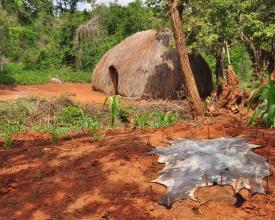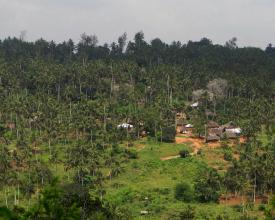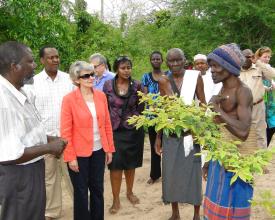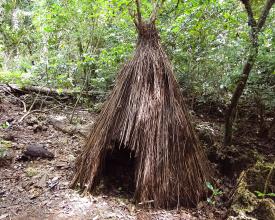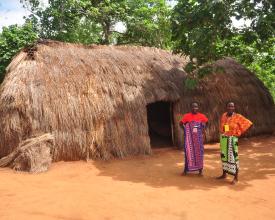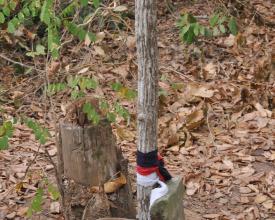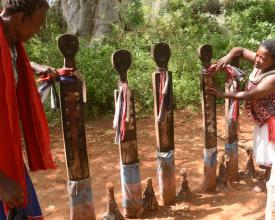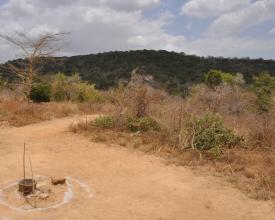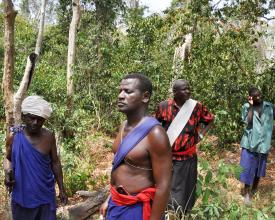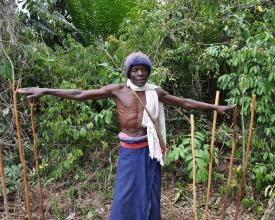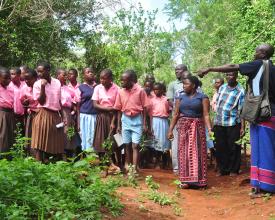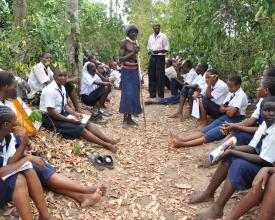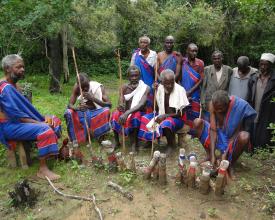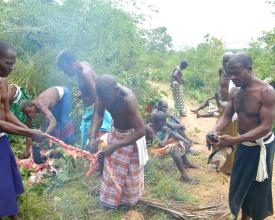
Protección integrada del patrimonio cultural y natural de los Bosques Sagrados de Mijikenda Kaya
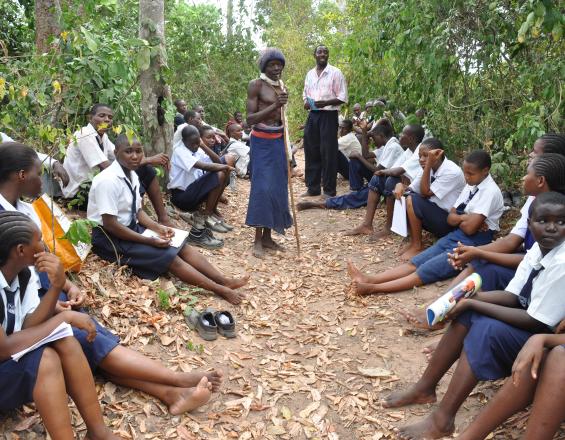
Los kayas y los bosques sagrados de la comunidad mijikenda son un lugar único para la conservación de especies botánicas endémicas de los bosques costeros de África Oriental y se consideran portadores de la identidad del grupo debido a su condición de lugares sagrados y hogar de los mijikenda.
La solución se centra en preservar el entorno natural que rodea a los Kayas mediante la continuación de un enfoque de gestión basado en los conocimientos tradicionales de los Mijikenda y en los principios de autocontrol supervisados por los líderes espirituales y el Consejo de Ancianos (Kambi). La protección de estos excepcionales yacimientos cuenta además con el apoyo de los Museos Nacionales de Kenia, que protegen los yacimientos a nivel institucional y jurídico.
Esta conexión única entre naturaleza, cultura y sacralidad ha llevado a inscribir los Bosques Sagrados Mijikenda Kaya en la Lista del Patrimonio Mundial y las tradiciones y prácticas mijikenda en la lista del Patrimonio Cultural Inmaterial que requiere medidas urgentes de salvaguardia.
Contexto
Défis à relever
- Desafíos medioambientales:pérdida de zonas forestales; explotación y uso insostenibles de los recursos naturales; recolección comercial; presión agrícola. Aumento de la población y la consiguiente presión sobre los recursos de la tierra.
- Retos culturales y sociales: pérdida de conocimientos tradicionales; los cambios en los entornos socioculturales han debilitado las estructuras tradicionales; fragmentación de las comunidades locales e indígenas; abandono de los kayas; cambios demográficos y en los estilos de vida e intolerancia religiosa hacia el carácter sagrado y las creencias espirituales de los mijikenda; urbanización y presiones urbanísticas. Falta de documentación adecuada y de reconocimiento por parte de las partes interesadas, falta de marcos jurídicos administrativos y nacionales para mejorar la protección de los elementos físicos y no físicos.
- Retos económicos: necesidad de crear medios de desarrollo sostenible y diferenciación de las fuentes de ingresos locales; disminución de la sostenibilidad económica de las comunidades locales.
Ubicación
Procesar
Resumen del proceso
La protección de los bosques sagrados kaya requiere un complejo sistema de reconocimiento de valores, asociaciones y protección del lugar a varios niveles. El marco general es el carácter interrelacionado e interdependiente de los valores naturales, culturales y espirituales, así como el importante papel desempeñado por la custodia de los Mijikenda y los ancianos kaya en la protección de estos valores y de la diversidad biocultural del lugar. Esto demuestra el papel fundamental que desempeñan los valores indígenas y espirituales en la protección de la naturaleza.
El sistema normativo tradicional de los mijikenda ha estado vigente durante más de cuatro siglos y ha permitido la conservación y protección de los kayas hasta nuestros días. Con los retos modernos de abandono de los kayas, pérdida de conocimientos tradicionales e intereses comerciales, la protección de los kayas ha requerido el establecimiento de más medios institucionales y gubernamentales de apoyo a la protección de los kayas y de los ancianos implicados en la conservación y protección del sitio. La inscripción en virtud de las disposiciones de las Convenciones del Patrimonio Mundial y del PCI ha reforzado aún más el apoyo existente para la protección de los caracteres tangibles e intangibles del lugar y de sus comunidades.
Bloques de construcción
Valores sagrados y culturales del bosque Mijikenda Kaya
Los bosques Mijikenda Kaya son pequeñas manchas de tierra forestal que se extienden entre 10 y 400 hectáreas en las llanuras costeras de Kenia. Originalmente se crearon en el siglo XVI como lugares de asentamiento, pero tras su abandono en la década de 1940 estos lugares se han definido sobre todo por sus valores espirituales y religiosos. Los bosques de Kaya desempeñan un papel clave en la esfera religiosa de los mijikenda, sus creencias y prácticas, ya que se consideran los hogares ancestrales y sagrados de los pueblos mijikenda.
La protección de los bosques Kaya de los Mijikenda requiere un enfoque holístico e integrado basado tanto en los valores naturales como en los culturales, así como en el reconocimiento del papel de los Mijikenda en la conservación del lugar a través de los sistemas de conocimiento tradicionales y el reconocimiento del carácter sagrado de estos lugares. Esta identificación y protección de valores a varios niveles es fundamental para la protección del lugar y de sus gentes en su totalidad: desde la salvaguarda de su carácter sagrado hasta la conservación de su diversidad biocultural.
Factores facilitadores
El conocimiento tradicional de los Mijikenda es clave para la tierra sagrada de los Kayas y la conservación de su naturaleza y cultura. Los mijikenda expresan el carácter sagrado del lugar mediante la práctica de tradiciones y artes escénicas relacionadas con acontecimientos importantes de la vida de los mijikenda; estas tradiciones forman el código ético y son la base del sistema de gobernanza vigente. La conservación eficaz cuenta además con el apoyo de los Museos Nacionales de Kenia, que a lo largo de los años han colaborado con los mijikenda en la protección de los kayas.
Lección aprendida
La protección a largo plazo de los kayas depende directamente de la supervivencia de los mijikenda y de sus tradiciones. La protección del entorno natural de los bosques kaya se basa en el reconocimiento de los valores sagrados otorgados a la naturaleza. Estos valores son protegidos y salvaguardados por los mijikenda a través de sus conocimientos tradicionales, pero también de la aplicación del código ético y del sistema de gobernanza, así como del cumplimiento de los principios de autocontrol por parte de las comunidades. Por esta razón, es importante abordar los retos socioculturales en el lugar y trabajar con los Mijikenda en el establecimiento de intercambios intergeneracionales para apoyar la continuación de estas prácticas y la salvaguardia de los valores culturales y sagrados.
La aplicación de los códigos éticos y las normas de los mijikenda ha permitido durante mucho tiempo la conservación, sin embargo, el cambio demográfico de los kayas y el abandono de estas zonas en favor de entornos urbanos ha llevado a la necesidad de seguir reforzando los marcos institucionales y jurídicos (tanto tradicionales como gubernamentales) de los kayas.
La custodia de los Mijikenda
La protección de los bosques Kaya de la costa de Kenia es un asunto primordial de los Mijikenda, nueve grupos étnicos de habla bantú (Chonyi, Duruma, Digo, Giriama, Jibana, Kambe, Kauma, Rabai y Ribe). Los pueblos mijikenda reconocen sus orígenes en los bosques de Kaya y han establecido sistemas normativos y códigos éticos tradicionales basados en el carácter sagrado de los bosques de Kaya y en la práctica de actuaciones tradicionales espirituales y sagradas como oraciones, juramentos, entierros, amuletos, nombramientos de recién nacidos, iniciaciones, reconciliaciones, coronaciones y otras. El uso de los recursos naturales de los bosques kaya está regulado por los conocimientos y prácticas tradicionales de los mijikeda. Estas prácticas prohíben cualquier explotación activa y comercial de los recursos naturales, y sólo permiten la recolección de troncos muertos y plantas utilizadas con fines espirituales y medicinales. Estas prácticas tradicionales contribuyen a la conservación de la biodiversidad de estos bosques.
La observancia de estos códigos éticos está supervisada por el Consejo de Ancianos (Kambi) y los líderes espirituales del pueblo mijikenda, que se encargan de velar por que no se incumplan los sistemas normativos tradicionales y se respete el bosque.
Factores facilitadores
La supervivencia de los bosques de Kaya depende en gran medida de los medios de subsistencia de los mijikenda y de su sistema tradicional. A medida que los miembros de la comunidad se desplazan hacia las zonas urbanas, la supervivencia de estas prácticas y tradiciones está en manos de los ancianos de los pueblos mijikenda. El proyecto y los programas se han establecido para fomentar el intercambio intergeneracional para la salvaguarda a largo plazo de estas prácticas espirituales y tradicionales, que son beneficiosas para la diversidad biocultural del lugar y la sostenibilidad de los propietarios tradicionales.
Lección aprendida
La custodia que ejerce el pueblo mijikenda es de gran importancia para la supervivencia de los valores tanto naturales como culturales y espirituales de los bosques sagrados de Kaya. Sin embargo, las comunidades de los Mijikenda se están degradando lentamente: con el aumento de la población de la zona y la necesidad de sostenibilidad local, los miembros de los Mijikenda han abandonado el lugar para vivir en zonas urbanas. Estos problemas se han abordado a través de dos medios clave: el fortalecimiento del marco institucional y de protección a nivel nacional (designación como monumento nacional y creación de la Unidad de Conservación de los Bosques Costeros dentro de los Museos Nacionales de Kenia) y la inscripción de las tradiciones y prácticas de los mijikenda en la lista del Patrimonio Cultural Inmaterial que requiere medidas urgentes de salvaguardia.
Conocimientos tradicionales y sistemas normativos de apoyo: asociaciones institucionales y normativas para la protección de los bosques de kaya
La protección de los bosques sagrados Mijikenda Kaya se garantiza mediante un doble conjunto de medidas tradicionales y legales que interactúan entre sí para proteger el lugar y garantizar el sustento de las comunidades y los pueblos. Además del marco normativo tradicional existente de los Mijikenda y el Consejo de Ancianos (Kambi), los 10 bosques kaya inscritos en la Lista del Patrimonio Mundial y muchos de estos bosques sagrados también han sido registrados como monumentos nacionales en virtud de las disposiciones de la Ley de Museos y Patrimonio Nacional, que obliga al gobierno keniata a apoyar a los ancianos kaya en la protección de los kaya. El registro original de 22 bosques kaya en 1992 provocó la necesidad de crear una nueva unidad especializada -la Unidad de Conservación de los Bosques Costeros- dentro de los Museos Nacionales de Kenia, cuya labor se centra aún hoy en trabajar en colaboración con los ancianos kaya para la protección de estos lugares.
Factores facilitadores
Este pilar fundamental es posible gracias a la existencia de asociaciones entre los mijikenda y las instituciones gubernamentales competentes encargadas de proteger el patrimonio natural y cultural de los lugares a escala local (sistemas normativos tradicionales), nacional (leyes y legislación nacionales) e internacional (Convenciones del Patrimonio Mundial y del Patrimonio Cultural Inmaterial). Esta cooperación ofrece a todos los titulares de derechos y partes interesadas la oportunidad de trabajar juntos y constituye una plataforma de comunicación entre los propietarios tradicionales y las instituciones gubernamentales.
Lección aprendida
El agotamiento y la degradación del tejido sociocultural del pueblo mijikenda han llevado a la necesidad de establecer un marco institucional de apoyo y colaboración con los ancianos kaya para la conservación de estos bosques sagrados. El sistema normativo tradicional vigente es un conjunto de medidas de protección que observan sobre todo los miembros de la comunidad, pero la degradación de la comprensión del papel de los kaya en la vida de los mijikenda y otras comunidades locales ha llevado progresivamente a la necesidad de un apoyo más institucionalizado mediante el establecimiento y la aplicación de marcos jurídicos de protección con sanciones definidas para las infracciones de las leyes y normativas.
Además, los intereses de explotación comercial de estas zonas, la acuciante invasión urbana y agrícola y las presiones para utilizar las tierras de los kayas han exigido la necesidad de una protección jurídica eficaz por parte del gobierno para cumplir los requisitos de la Convención del Patrimonio Mundial.
Protección sinérgica en el marco de las Convenciones de la UNESCO: Patrimonio Mundial y Patrimonio Cultural Inmaterial
La protección de los kayas depende directamente de la protección de los atributos/elementos naturales y culturales -tangibles e intangibles- del sitio y de su sistema de conocimientos y prácticas tradicionales. Esta necesidad de protección integrada no sólo se refleja a nivel local mediante el reconocimiento de la custodia, sino que también se reconoce y protege internacionalmente mediante la inscripción del sitio en la lista de la Convención para la Protección del Patrimonio Mundial Cultural y Natural (inscrito como Bosques Sagrados de Mijikenda Kaya) y la inclusión de las tradiciones y prácticas asociadas a los kayas en los bosques sagrados de Mijikenda en la lista de elementos que requieren medidas urgentes de salvaguardia de la Convención de la UNESCO para la Salvaguardia del Patrimonio Cultural Inmaterial.
La doble inscripción ofrece un marco internacional añadido para abordar tanto la protección del patrimonio natural y cultural como el Valor Universal Excepcional de los bosques sagrados de kayas del Mijikenda. Además, apoya los esfuerzos realizados para abordar directamente la necesidad de comprometerse de forma urgente y proactiva con la salvaguardia de tradiciones que se enfrentan a importantes retos y que podrían desaparecer algún día.
Factores facilitadores
La inscripción en la Lista del Patrimonio Mundial y en la Convención del Patrimonio Cultural Inmaterial ha sido un esfuerzo colectivo del Estado de Kenia, los Museos Nacionales de Kenia, la Comisión Nacional de Kenia para la UNESCO y los pueblos mijikenda.
Esta adecuada conservación, protección y salvaguardia de los kayas es posible gracias a la activa red de socios tradicionales e institucionales comprometidos en la conservación del sitio a nivel local, regional, nacional e internacional.
Lección aprendida
La Convención del Patrimonio Mundial se ocupa de la protección del Valor Universal Excepcional de un sitio y de los atributos portadores de tales valores; por su parte, la Convención del Patrimonio Cultural Inmaterial se centra en el patrimonio cultural de tradiciones, expresiones vivas heredadas por antepasados y generaciones anteriores. Estas inscripciones oficializaron el reconocimiento del carácter interdependiente de los valores materiales e inmateriales del sitio, cuya protección es necesaria tanto en términos de patrimonio natural y cultural como de salvaguardia de los conocimientos tradicionales de los mijikenda en su papel de propietarios y custodios tradicionales.
La inscripción en el PCI en Necesidad de Salvaguardia Urgente ha apoyado el establecimiento y la creación de actividades para la salvaguardia de las tradiciones y prácticas de los mijikenda (trabajos de restauración, intercambios intergeneracionales, premios a los bosques de kaya mejor gestionados), así como actividades de salvaguardia comunitaria como la apicultura y la venta de miel, la cría de mariposas y la venta de pupas a mercados internacionales para la sostenibilidad socioeconómica de las comunidades locales kaya vecinas.
Impactos
La conservación del medio ambiente y la naturaleza se ve reforzada por el reconocimiento de los bosques como lugares sagrados que no pueden explotarse con fines económicos, lo que fortalece los servicios ecosistémicos.
La conservación de la naturaleza y la cultura son interdependientes: por un lado, el reconocimiento de la naturaleza como sagrada es clave para la conservación de los bosques y el medio ambiente de los kayas y, por otro, la conservación de la naturaleza es necesaria para conservar los valores culturales y espirituales asociados a los kayas y a los bosques sagrados de los mijikenda. Estos lugares son mantenidos como lugares sagrados y cementerios por las comunidades locales dirigidas por sus ancianos. El acceso a los bosques kaya está controlado y sólo se permite la entrada a los ancianos iniciados (y en algunos casos ni siquiera a ellos). Los miembros no iniciados y los visitantes sólo pueden acceder a estos lugares con permiso de los ancianos. Los rituales especiales y la utilización de los recursos pueden concederse mediante autorizaciones especiales.
La conexión espiritual entre los recuerdos de los antepasados que vivieron y fueron enterrados en estos lugares y lo natural refuerza el carácter sagrado, y justifica la necesidad de su protección y explotación negativa.
La sostenibilidad de los medios de vida y las comunidades locales. Los habitantes locales dependen de estos bosques para su seguridad alimentaria, fuentes de agua y "almacén" de medicina tradicional y hierbas para la atención sanitaria de la comunidad.
Beneficiarios
Los beneficiarios de estas protecciones integradas son los kayas y los mijikenda. Otros beneficiarios son las comunidades locales y las instituciones gubernamentales (sobre todo en relación con la autoridad de los ancianos).

